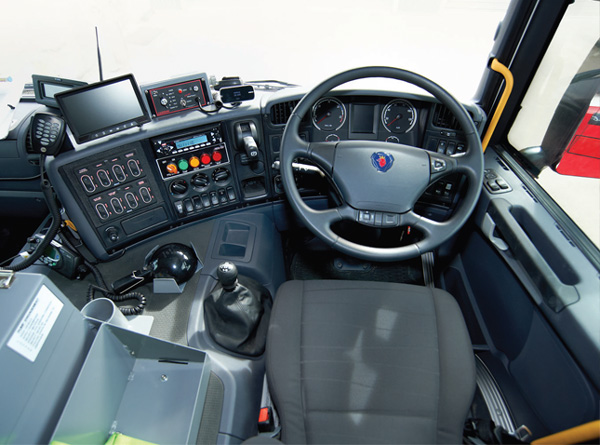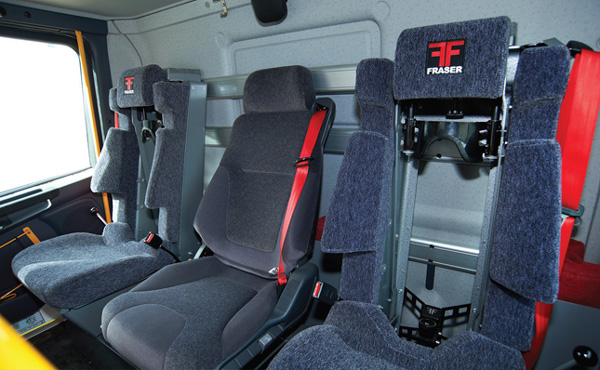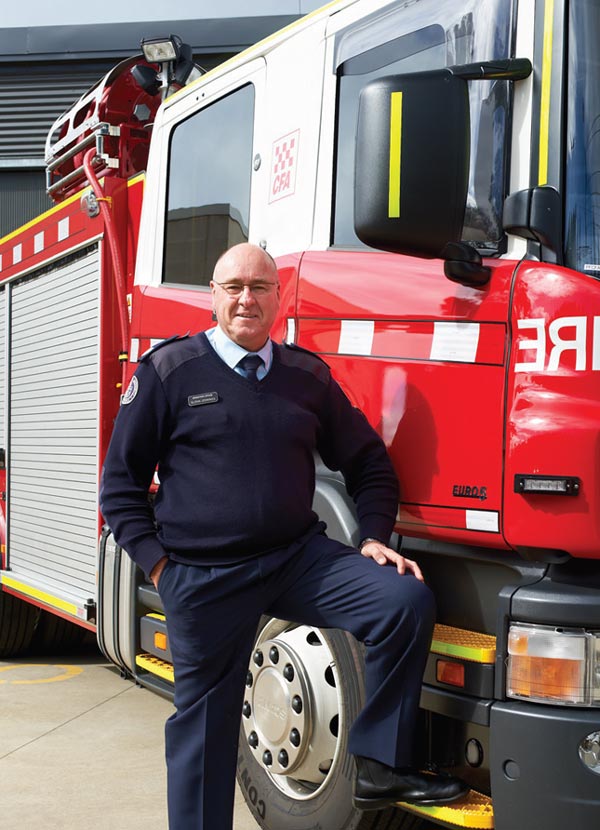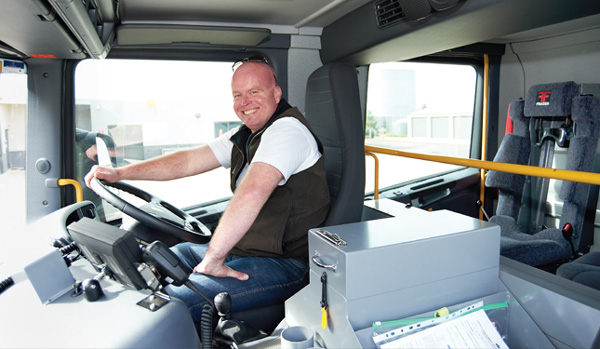Scania has been kicking goals recently with its ready-to-rock emergency vehicle solutions. One such solution is the Scania P320 4x2 pumper
I got to drive a big red fire engine, flashing lights and all.
The truck I drove is among the first batch of P series Scania fire trucks delivered to the Victorian Country Fire Authority (CFA).
This represents a major shift in truck preference for the CFA after many years of Japanese makes and models. The P320 4×2 pumper I drove was about to go into service with the Geelong City CFA station, but I managed to get my mitts on it before it went into service.
The Lara CFA station is still a volunteer operation and is the largest volunteer station in Victoria. The Lara station is usually home to two tankers and a pumper as well as a truck owned by the local community. And it was here I met Fiskville-based Glenn Jennings, CFA Operations Officer, Driving and Vehicle Operations, and the gleaming new Scania P320 4×2 pumper.
There are now 70 Scania’s in the CFA fleet and 50 of those are pumpers. One of the big attractions of the Scania is it’s a purpose built out-of-the-box emergency vehicle.
Engine
The Scania P320 4×2 pumper has a cylinder DC9 engine, which muttered away under the floor. While it may be quiet, smooth application of the go-pedal meant the pumper took off up the street like a startled gazelle.
With 1,600Nm of torque on tap, from 1,000rpm and a 4.88 final drive ratio, acceleration was very impressive.
Transmission
The job of translating power from the engine to the rear wheels goes via a 6-speed Allison GA766R (MD 3066) automatic transmission.
Cab and Controls
This truck has a CP28 cab that translates into a 28-inch (71cm) extension to a standard P series cab.
There’s also a CP31 version available that can accommodate an extra row of rear facing seats. But even in the shorter guise I looked over, there were some interesting improvements over past vehicles.
For a start, the rear seats can now house breathing apparatus, which means the crew are wearing their gear and ready to go when they get to the fire.
There’s also a flip down rear step for the crew that deploys automatically when the rear doors are opened — making it easier for the crew to exit the cab safely while wearing all their kit.
Another big plus for the Scania is the electronic stability control (ESC). It stands to reason that in an emergency, when the vehicle is in a hurry, under lights and sirens, safety is paramount. And Jennings admits the ESC is a great help keeping things on the straight and narrow regardless of the experience of the person behind the wheel.
On the back of the Scania is a Mills-Tui pump unit with built in generator that has a water capacity of 2,000 litres and a B class foam capacity of 200 litres.
The foam is used for flammable liquid fires and flame suppression in vehicle accidents. But this baby can be hooked up to six fire hydrants at once and can push out water at an astonishing 4,700l/m. That equates to about 4 tonnes of water every 60 seconds. Just quietly, I reckon that would be more than enough to decapitate the neighbours’ geraniums.
However, the unit generally only runs at 115l/m on first response. Pressure is ramped up once the crew are inside a burning structure.
Having the water on board means the crew can quickly get water onto the fire while the pump unit is being hooked up to the hydrants.
Performance
With Jennings riding shotgun in the passenger seat to prevent me from fiddling with any of the cool buttons on the instrument panel, we were able to chat some more about the Scania invasion of the CFA.
The standard response time guideline for the first truck on scene is 7.7 minutes.
Jennings says the new Scanias are blitzing this and, according to their calculations, would still nearly 2km further down the road in the same amount of time.
The DC9 engine may be of modest size but the combination of driveline ratio and transmission made it a slick, smooth performer. And I must say, for an Allison-equipped vehicle, it was surprisingly quiet and without the characteristic Allison whine from days gone by.
In fact, the only whine was probably coming from me as I wanted to use the lights and sirens.
Merging onto the freeway confirmed the impressive performance of the truck. As a civilian, I wasn’t allowed to use the trucks 110km/h top speed, but it sure got to 100 in a hurry. But it was the lack of noise and smooth delivery of power that really stood out.
For a short wheelbase heavy vehicle the Scania also sat on the open road well with no twitchiness.
Once off the highway and in a controlled environment, Jennings finally relented and let me use the emergency lights.
I was grinning like a fool as I roared up and down the street. The 4×2 configuration and sharp steer angle of the P series also made it quite nimble and I was able to easily poke it around all sorts of traffic furniture from roundabouts, designed for light vehicles, to the concrete chicanes in housing estates.
I also took the opportunity to ask Jennings about exhaust gas recirculation (EGR) and the challenges this poses for vehicles that are used off-road. The vast majority of Euro 5 (ADR80/03) EGR vehicles use active regeneration to clear the diesel particulate filter (DPF) of soot when it becomes clogged.
A small diesel injector feeds a burner within the DPF which can generate temperatures of up to 650C.
Most EGR vehicles, such as fire trucks, have the DPF underneath the chassis, so it comes as no surprise this could be a fire hazard in itself if the vehicle was parked in long grass when it went into a regeneration cycle. In answer to this, Jennings pointed out standard procedure on high risk days or days of total fire ban is all of the trucks are parked out the front of the station and have a manual regeneration cycle performed.
This should mean the truck will be ready to head into the bush at a moment’s notice without any afterburner worries. If a vehicle needs to undergo a regeneration cycle while fighting a fire, CFA procedure is it must leave the fire ground and regenerate in a clear safe area.
Bearing this in mind Scania has also brought a selective catalytic reduction (SCR) version of the 9-litre engine into the country in an off-road 4×4 crew cab specification. Clearly this makes a lot more sense as this is the kind of vehicle that is most likely to end up out in the bush fighting bushfires in long grass.
The 4×4 version however doesn’t use the Allison transmission, in relies instead on Scania’s Opticruise AMT instead.
In major cities, Bronto Skylift equipped 8×4 Scania’s are a common sight, while the Victorian Police — Search and Rescue Squad have also taken delivery of their own 4×2 P Series crew cab.
Verdict
The CFA reckons the P Series has taken fire engine ergonomics to a new level.
But for me it was enough to live out a childhood fantasy of finally driving a big red fire engine.
Specifications
Make/model: Scania P320 4×2 Pumper
Engine: 9-litre 5 cylinder DC9 turbo diesel engine with common-rail injection
Emissions: Euro 5 EGR
Power: 320hp (235kW)
Torque: 1,600Nm @ 1,100 — 1,200rpm
Transmission: 6-speed Allison MD 3066 automatic with integrated retarder
Final drive: 4.88
Additional features: Climate control for front and rear compartments, ESC, retractable crew steps for rear passenger
Pump body: Mills-Tui







